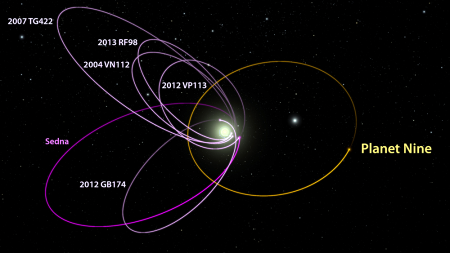Konstantin Batygin and Mike Brown at the California Institute of Technology generated a lot of excitement in the science world back in January when they announced that they had found evidence of a giant planet traveling in an odd, drawn-out orbit in the far reaches of the solar system.
So far the new found planet, unofficially nicknamed Planet 9 – as in our solar system’s 9th planet if confirmed – has not been directly imaged. But, the Caltech scientists say the behavior of several distant Kuiper Belt objects have shown signs of being gravitationally affected by an object with a mass that’s about 10 times greater than Earth, and 5,000 times that of Pluto.

This artistic rendering shows the distant view from Planet Nine back towards the sun. (Caltech/R. Hurt (IPAC))
“Planet Nine” is thought to orbit the sun from a distance of nearly 20 times farther than Neptune, whose average distance to the sun is about 4.5 billion kilometers.
Astrophysicists at the University of Bern wanted to know more about Planet 9, such as its size, temperature, and what kind of telescope would be needed to find it.
Christoph Mordasini, a professor at the University of Bern, along with PhD candidate Esther Linder have modelled the evolution of the purported Planet 9.
Writing in the journal “Astronomy & Astrophysics”, the Swiss scientists say their modelling allows them to assume that Planet 9 is a small ice giant, smaller than Uranus and Neptune, and that it is surrounded with a blanket of hydrogen and helium.
They say their models show the mass of Planet 9 is 10 times the mass of Earth, the same reported by Brown and Batygin in January and that its radius is about 23,572 km, or 3.7 times that of Earth (6,371 km).
The researchers calculated that Planet 9’s current temperature is around -226° Celsius (47 Kelvin). They say it’s that warm because its core is cooling; otherwise its temperature would only be about 10 Kelvin (-263° Celsius).

Orbital paths of the six most distant known objects in the solar system (magenta) along with theorized path of “Planet Nine”. (Lance Hayashida/Caltech)
Since most of the putative planet’s emitted energy appears to be coming from the cooling of the core and not reflected light from the sun, Mordasini and Linder suggest that Planet 9 may be much brighter in the infrared wavelengths rather than visible light.
The scientists say that the planet hasn’t shown up in past sky surveys because it would have been very difficult to spot an object with a mass 20 times that of Earth or less, especially if it was near its Aphelion, or farthest point from the Sun.
They think that either future telescopes, such as the Large Synoptic Survey Telescope now under construction near Cerro Tololo in Chile, or dedicated surveys specifically tasked with looking for Planet 9 should be able to find or rule out whether or not Planet 9 actually exists.
Meanwhile NASA’s Jet Propulsion Laboratory is putting to rest recent news reports that allege Planet 9 or perhaps another mystery planet beyond the orbit of Neptune is behind a mysterious anomaly in the orbit of its Cassini spacecraft around Saturn.
Mission managers and orbit determination experts at JPL say that Cassini is not experiencing unexplained deviations described in the news reports and that no such abnormalities have been observed since the spacecraft arrived at Saturn in 2004.
“An undiscovered planet outside the orbit of Neptune, 10 times the mass of Earth, would affect the orbit of Saturn, not Cassini,” said William Folkner, a planetary scientist at JPL in a NASA press release.
A recently published paper suggested that if scientists were able to track Cassini’s position up to 2020, it might be able to find the mystery planet’s “most probable” location.
NASA, however said that by 2020 the Cassini spacecraft, whose mission is scheduled to end in September 2017, will have run out of fuel and plunged into Saturn’s atmosphere.
























Reviewing the history or making an condition for proving the history?